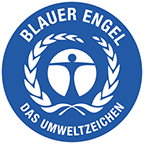
Blue Angel
– the oldest and best-known eco-label in Europe!
For over 35 years, the Blue Angel has been a seal of quality whose purpose is environmental and consumer protection. Consumers can see for over 110 product groups whether a product has been tested for environmental friendliness.
The Blue Angel is awarded to products that meet the strict requirements of the evaluation committee. This consists, among others, of representatives of Stiftung Warentest, the Consumer Center, the Central Association of German Trades, the Federation of German Industries, the German Trade Union Federation (DGB) and the TU Berlin.
Lasting emissions reduction:
Put through its paces!
With the Blue Angel, much more is tested than is required by law. The goal is to ensure that a catalytic converter, for example, permanently performs what it promises to. In addition to the tests required by law, more demanding tests are prescribed.
Aging test
The coating of the catalytic converter requires expensive rare earths. If this is skimped on, then the catalytic effect quickly diminishes. This is why Blue Angel catalytic converters have to pass an elaborate aging test. In this process, three-way catalytic converters are artificially aged at 980 °C using a hydrothermal process. After that, the exhaust values are measured again and must still meet the pollutant requirements.
Precious metals analysis
A highly specialized Blue Angel-approved testing lab determines whether the platinum, rhodium, and palladium content match the manufacturer’s specifications. This ensures the required material quality for long-term use.
Component measurement
The manufacturer’s specifications must be consistent with the sample. Thus, there must be no deviation in, for example, the dimensions or the number of cells of the catalytic carrier used.
Constructive design
Replacement catalytic converters often deviate from the design of the original for cost reasons. With LRT catalytic converters, this is only done to improve a defective original.
On-Board Diagnostics check
In the OBD system, the vehicle’s on-board computer notes when the catalytic converter is malfunctioning (mandatory for gasoline engines since 1/1/2001). The catalytic converter sample must pass all mandatory OBD tests.
Hot Shake
The most important component of a catalytic converter, the carrier, must remain firmly and securely installed in its surrounding metal jacket for years to come at an operating temperature of just under 1,000 °C. If not, then a ceramic carrier breaks after a short period of time. Therefore, Blue Angel catalytic converters have to pass a vibration test with 30 million(!) Load changes at an operating temperature of 980 °C – an important criterion for the longevity of the catalytic converter.
Environmental friendliness
To ensure that a ceramic carrier can be installed in a stable fashion, it is embedded in a bearing or swelling mat. This is usually carcinogenic. Blue Angel therefore sets the strictest requirements for the biopersistence, and carcinogenicity of the mineral fibers or high-temperature wool used.
Aging test
The coating of the catalytic converter requires expensive rare earths. If this is skimped on, then the catalytic effect quickly diminishes. This is why Blue Angel catalytic converters have to pass an elaborate aging test. In this process, three-way catalytic converters are artificially aged at 980 °C using a hydrothermal process. After that, the exhaust values are measured again and must still meet the pollutant requirements.
Precious metals analysis
A highly specialized Blue Angel-approved testing lab determines whether the platinum, rhodium, and palladium content match the manufacturer’s specifications. This ensures the required material quality for long-term use.
Component measurement
The manufacturer’s specifications must be consistent with the sample. Thus, there must be no deviation in, for example, the dimensions or the number of cells of the catalytic carrier used.
Constructive design
Replacement catalytic converters often deviate from the design of the original for cost reasons. With LRT catalytic converters, this is only done to improve a defective original.
On-Board Diagnostics check
In the OBD system, the vehicle’s on-board computer notes when the catalytic converter is malfunctioning (mandatory for gasoline engines since 1/1/2001). The catalytic converter sample must pass all mandatory OBD tests.
Hot Shake
The most important component of a catalytic converter, the carrier, must remain firmly and securely installed in its surrounding metal jacket for years to come at an operating temperature of just under 1,000 °C. If not, then a ceramic carrier breaks after a short period of time. Therefore, Blue Angel catalytic converters have to pass a vibration test with 30 million(!) Load changes at an operating temperature of 980 °C – an important criterion for the longevity of the catalytic converter.
Environmental friendliness
To ensure that a ceramic carrier can be installed in a stable fashion, it is embedded in a bearing or swelling mat. This is usually carcinogenic. Blue Angel therefore sets the strictest requirements for the biopersistence, and carcinogenicity of the mineral fibers or high-temperature wool used.
Blue Angel catalytic converters –
Continuously tested quality in the name of environmental protection!
A manufacturer’s Blue Angel program is reviewed annually. To do this, a Blue Angel-approved testing lab selects a random sample and purchases the Blue Angel catalytic converters from any dealer. The date, sample, and source of supply are unknown to the manufacturer. Therefore, there is no room for manipulation with Blue Angel. Customers can thus be sure that they are purchasing a continuously tested quality product when they buy catalytic converters with the Blue Angel seal.
The Blue Angel is therefore not just any eco-label - it is the outstanding eco-label par excellence.
Why catalytic converters with the Blue Angel seal cost more
1
Costs for measurements for the initial award of the seal exceed a six-figure amount
2
Follow-up costs due to annual follow-up measurements
3
Annual fee for the authorization to use the Blue Angel as a seal
4
Increased material costs to meet measurement requirements and ensure durability
5
Implementation of new processes and machines